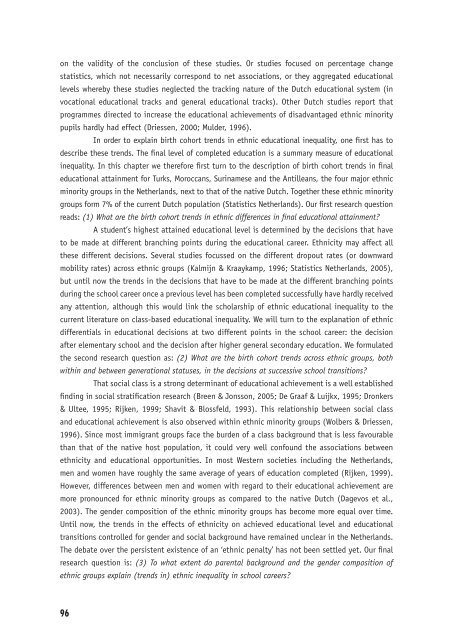Ethnic Hostility among Ethnic Majority and Minority Groups
Ethnic Hostility among Ethnic Majority and Minority Groups
Ethnic Hostility among Ethnic Majority and Minority Groups
Create successful ePaper yourself
Turn your PDF publications into a flip-book with our unique Google optimized e-Paper software.
on the validity of the conclusion of these studies. Or studies focused on percentage change<br />
statistics, which not necessarily correspond to net associations, or they aggregated educational<br />
levels whereby these studies neglected the tracking nature of the Dutch educational system (in<br />
vocational educational tracks <strong>and</strong> general educational tracks). Other Dutch studies report that<br />
programmes directed to increase the educational achievements of disadvantaged ethnic minority<br />
pupils hardly had effect (Driessen, 2000; Mulder, 1996).<br />
In order to explain birth cohort trends in ethnic educational inequality, one fi rst has to<br />
describe these trends. The fi nal level of completed education is a summary measure of educational<br />
inequality. In this chapter we therefore fi rst turn to the description of birth cohort trends in fi nal<br />
educational attainment for Turks, Moroccans, Surinamese <strong>and</strong> the Antilleans, the four major ethnic<br />
minority groups in the Netherl<strong>and</strong>s, next to that of the native Dutch. Together these ethnic minority<br />
groups form 7% of the current Dutch population (Statistics Netherl<strong>and</strong>s). Our fi rst research question<br />
reads: (1) What are the birth cohort trends in ethnic differences in fi nal educational attainment?<br />
A student’s highest attained educational level is determined by the decisions that have<br />
to be made at different branching points during the educational career. <strong>Ethnic</strong>ity may affect all<br />
these different decisions. Several studies focussed on the different dropout rates (or downward<br />
mobility rates) across ethnic groups (Kalmijn & Kraaykamp, 1996; Statistics Netherl<strong>and</strong>s, 2005),<br />
but until now the trends in the decisions that have to be made at the different branching points<br />
during the school career once a previous level has been completed successfully have hardly received<br />
any attention, although this would link the scholarship of ethnic educational inequality to the<br />
current literature on class-based educational inequality. We will turn to the explanation of ethnic<br />
differentials in educational decisions at two different points in the school career: the decision<br />
after elementary school <strong>and</strong> the decision after higher general secondary education. We formulated<br />
the second research question as: (2) What are the birth cohort trends across ethnic groups, both<br />
within <strong>and</strong> between generational statuses, in the decisions at successive school transitions?<br />
That social class is a strong determinant of educational achievement is a well established<br />
fi nding in social stratifi cation research (Breen & Jonsson, 2005; De Graaf & Luijkx, 1995; Dronkers<br />
& Ultee, 1995; Rijken, 1999; Shavit & Blossfeld, 1993). This relationship between social class<br />
<strong>and</strong> educational achievement is also observed within ethnic minority groups (Wolbers & Driessen,<br />
1996). Since most immigrant groups face the burden of a class background that is less favourable<br />
than that of the native host population, it could very well confound the associations between<br />
ethnicity <strong>and</strong> educational opportunities. In most Western societies including the Netherl<strong>and</strong>s,<br />
men <strong>and</strong> women have roughly the same average of years of education completed (Rijken, 1999).<br />
However, differences between men <strong>and</strong> women with regard to their educational achievement are<br />
more pronounced for ethnic minority groups as compared to the native Dutch (Dagevos et al.,<br />
2003). The gender composition of the ethnic minority groups has become more equal over time.<br />
Until now, the trends in the effects of ethnicity on achieved educational level <strong>and</strong> educational<br />
transitions controlled for gender <strong>and</strong> social background have remained unclear in the Netherl<strong>and</strong>s.<br />
The debate over the persistent existence of an ‘ethnic penalty’ has not been settled yet. Our fi nal<br />
research question is: (3) To what extent do parental background <strong>and</strong> the gender composition of<br />
ethnic groups explain (trends in) ethnic inequality in school careers?<br />
96












